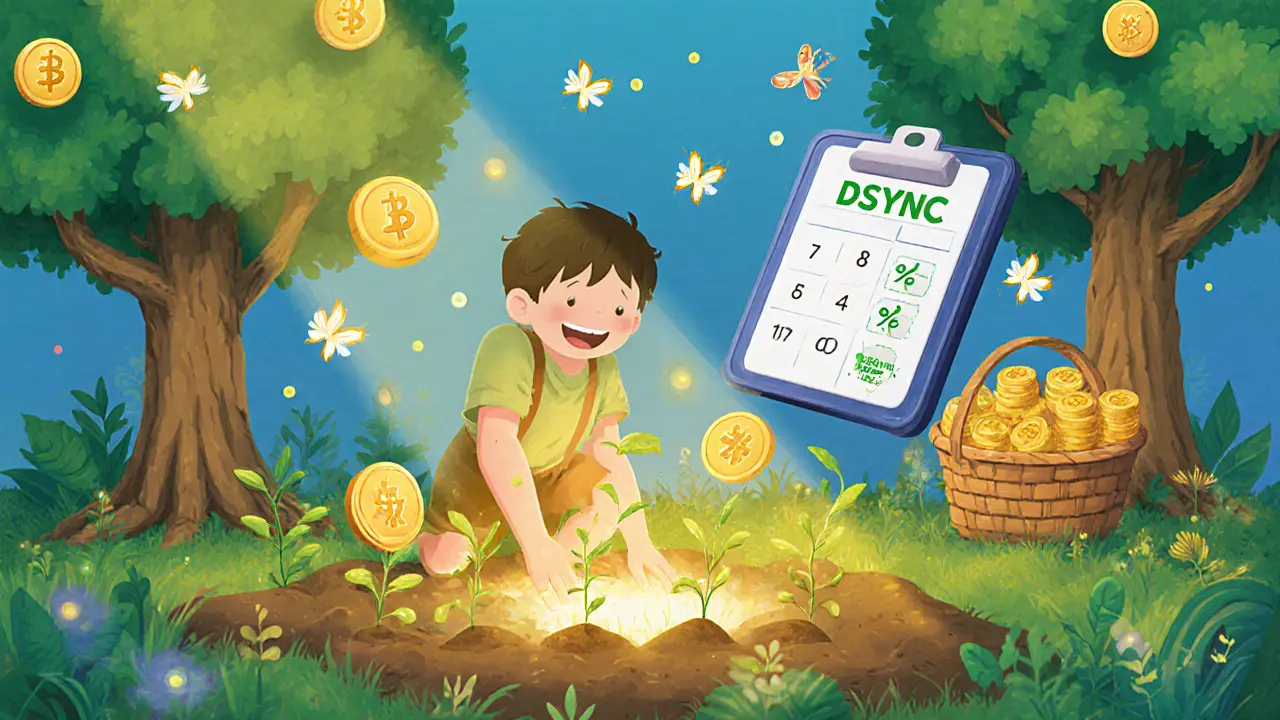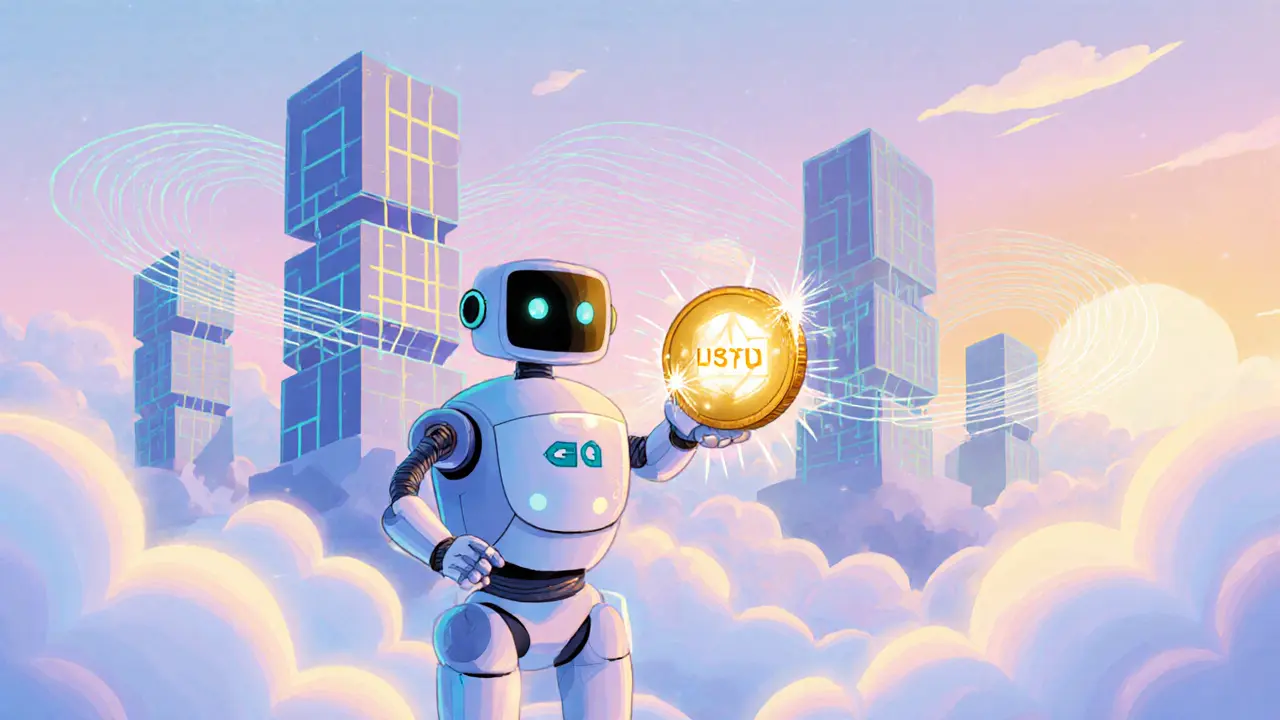Destra Network (DSYNC) Token Calculator
Current Market Data
Staking Calculator
Staking Rewards Projection
Enter your stake amount and reward rate to see projected earnings.
How Staking Works
- Minimum stake: ~10,000 DSYNC
- Rewards distributed from transaction fees
- Stakers earn 50% of node rewards
- Staking helps validate network performance
Destra Network is a decentralized AI and cloud computing platform that powers the DSYNC utility token. It combines blockchain, GPU‑based computing, and content‑addressed storage to offer a truly distributed infrastructure for AI‑heavy workloads.
TL;DR
- Destra Network (DSYNC) is a utility token for a decentralized AI‑cloud platform.
- It uses DSync tech, IPFS, ENS, and live GPU nodes to provide AI training, deployment, and storage.
- As of Oct2025 the token trades around $0.088 with ~US$4.5M daily volume.
- Staking lets holders validate the network and earn rewards.
- Key competitors include Akash Network (AKT) and Bittensor (TAO).
What Is Destra Network?
At its core, Destra Network is a Layer‑2 blockchain built specifically for infrastructure services. The native token, DSYNC (DSYNC token), acts as the medium of exchange for buying compute, storage, and AI model access on the platform.
The project’s mission is simple: replace the centralized cloud giants with a community‑run network where every GPU, storage node, and DNS entry is owned by participants rather than a single corporation. By doing so, Destra aims to give developers and enterprises full control over data sovereignty, pricing, and performance.
Technical Architecture
The backbone of the platform is the proprietary DSync technology. Unlike traditional location‑based addressing, DSync uses content‑based addressing, meaning data is fetched by its hash rather than where it lives. This approach, borrowed from IPFS, guarantees that files are immutable and available as long as any node stores the hash.
Key components include:
- IPFS - the peer‑to‑peer storage layer.
- ENS - human‑readable naming for contracts and nodes.
- Destra Nodes - compute units that run GPU workloads and report performance metrics.
- Decentralized DNS - allows domains to be resolved without a central registrar.
All transactions-whether you’re renting a GPU minute or staking DSYNC-settle on the Layer‑2 chain, which inherits security from its Ethereum parent while achieving lower fees and faster finality.
Services and Use Cases
Destra’s service suite is tailored for the AI economy:
- AI & LLM Training - developers can spin up GPU clusters on demand, paying only for actual usage.
- One‑Click AI Deployment - a web UI lets users push trained models to production with a single click.
- Proprietary AI Models - the network hosts its own cutting‑edge models, accessible via the token economy.
- D‑Rigs - hardware bundles that boost throughput for heavy‑duty inference tasks.
- Live Staking - token holders can lock DSYNC to help validate node performance and earn a share of transaction fees.
Typical users range from independent AI researchers needing cheap GPU time to enterprises looking for secure, decentralized data pipelines.

Tokenomics and Market Snapshot (Oct2025)
DSYNC is classified as a utility token. Its circulating supply isn’t publicly disclosed, which makes market‑cap calculations tricky. The latest price data (Oct22025) shows:
- Price: $0.08802
- 24‑hour volume: $4,498,684.59
- 24‑hour price change: +1.30%
- 7‑day price change: -3.40%
Compared with the broader crypto market (up ~3% over the same week), DSYNC underperformed, reflecting the typical volatility of niche infrastructure tokens.
Staking and Participation
Destra’s live staking model lets any DSYNC holder become a validator for the network’s GPU and storage nodes. While the official documentation doesn’t list exact minimums, community reports suggest a threshold of roughly 10,000DSYNC to start earning meaningful rewards.
Rewards are paid in DSYNC and are calculated based on:
- Amount of tokens staked.
- Uptime and performance of the nodes you back.
- Overall network usage-more AI jobs mean higher fee pools.
Stakers also gain voting rights on protocol upgrades, giving them a say in future roadmap decisions.
How Destra Stacks Up Against Competitors
| Feature | Destra Network | Akash Network (AKT) | Bittensor (TAO) |
|---|---|---|---|
| Primary Focus | AI‑centric GPU & storage | General‑purpose cloud compute | Decentralized machine‑learning incentives |
| Native Token | DSYNC | AKT | TAO |
| Content‑Addressed Storage | IPFS + DSync | IPFS | IPFS (limited) |
| GPU Availability | Live GPU nodes with real‑time metrics | CPU‑focused, limited GPU | GPU via staking rewards |
| AI Model Marketplace | Proprietary models & one‑click deployment | None | Model staking incentives |
| Staking Rewards | DSYNC fees + validation rewards | AKT inflation + compute fees | TAO inflation + model rewards |
Destra’s niche is clear: it targets AI workloads that need high‑throughput GPU power, whereas Akash serves broader compute needs and Bittensor focuses on incentivizing model training itself.
Risks and Considerations
Like any emerging crypto‑infrastructure project, DSYNC carries several risk factors:
- Liquidity uncertainty - daily volume is decent, but the lack of a known circulating supply can make price discovery volatile.
- Adoption gap - community chatter is sparse, suggesting limited mainstream developer uptake so far.
- Technical opacity - detailed onboarding guides and SDK documentation are not fully public, which may deter newcomers.
- Regulatory exposure - as a utility token tied to AI services, future regulations on AI data handling could affect operations.
Potential investors should weigh these factors against the platform’s long‑term vision for decentralized AI infrastructure.
Getting Started with DSYNC
- Set up an Ethereum‑compatible wallet (e.g., MetaMask).
- Purchase DSYNC on a supported exchange (most list it on major DEXes; always verify the contract address).
- Visit the official Destra portal and connect your wallet.
- If you want compute power, allocate DSYNC to a GPU node via the “Rent GPU” UI.
- To stake, navigate to the “Staking” section, lock the desired amount, and confirm the transaction.
- Monitor node performance and reward accrual in the dashboard’s “Staking Rewards” tab.
Remember to keep a backup of your seed phrase and never share private keys. Because the platform is still evolving, test with a modest amount before scaling up.

Frequently Asked Questions
What does DSYNC stand for?
DSYNC is the ticker symbol for the utility token that fuels the Destra Network. It doesn’t represent an acronym; the name mirrors the platform’s DSync technology.
How can I earn rewards with DSYNC?
By staking DSYNC you become a validator for GPU and storage nodes. The network distributes transaction fees and a portion of newly minted tokens to active validators based on their stake size and node performance.
Is there a minimum amount required to stake?
Public guidelines suggest roughly 10,000DSYNC as a practical entry point, though the protocol technically accepts any amount. Smaller stakes earn proportionally smaller rewards.
Can I use Destra Network for non‑AI workloads?
Yes, the underlying compute layer can run generic applications, but the platform’s UI, pricing models, and marketing are optimized for AI training, inference, and model deployment.
Where can I find the official DSYNC contract address?
The contract address is listed on the official Destra Network website and verified on reputable blockchain explorers like Etherscan. Always double‑check the address before transferring funds.


Comments
april harper
The rhythm of decentralization sings a quiet hymn in the background of markets, unseen yet ever‑present. Still, I can’t help but wonder if DSYNC will ever break free from its own shadows.
January 12, 2025 AT 18:53
Clint Barnett
When you first stare at the DSYNC price chart, it feels like watching a sunrise over a calm sea, each pixel a promise of potential. But beyond the pretty numbers lies a network that claims to reward stakers with half of node fees, which is an intriguing economic model. The minimum stake of roughly ten thousand tokens might seem steep to the casual investor, yet it also ensures that participants have some skin in the game. Imagine a community where every transaction not only moves value but also feeds the very validators that keep the chain secure. That feedback loop can ignite a virtuous cycle, driving higher usage and, in turn, larger rewards for diligent stakers. Of course, the 24‑hour volume hovering around four and a half million dollars hints at decent liquidity, though volatility remains a wild card. The modest 1.3 % daily uptick is encouraging, but the week‑long dip of 3.4 % reminds us that crypto markets love to swing. Staking calculators, like the one embedded in the site, give a hands‑on feel for projected annual yields, making abstract percentages more tangible. If you plug in ten thousand DSYNC and a realistic reward rate, the tool will show you a slice of the pie that could be quite satisfying over a year. Moreover, the distribution of 50 % of node rewards to stakers adds a layer of transparency that many projects lack. Transparency, however, is only as good as the data you can verify on‑chain, and auditors will need to keep an eye on fee allocations. Community governance also plays a role; proposals that adjust fee structures could tilt the balance in favor of either stakers or developers. In that sense, staying active on forums and voting becomes part of the staking strategy itself. From a technical standpoint, the network’s consensus mechanism appears robust, but it hasn’t yet weathered a major market downturn. That said, early adopters often reap outsized rewards when a protocol finally hits mainstream adoption. All things considered, DSYNC offers a compelling blend of staking incentives and community involvement, worth a deeper dive for anyone chasing yield in the crypto wild west.
January 20, 2025 AT 03:53
Jacob Anderson
Wow, a whole fifteen‑sentence love letter to a token that barely moved today. Clearly, the future of finance hinges on whether DSYNC can push $0.09. Spoiler: it probably won’t.
January 27, 2025 AT 12:53
Kate Nicholls
The staking rewards look decent on paper, but the real test will be how the network handles a sudden surge in transaction volume. If the fee pool dries up, rewards could evaporate quickly.
February 3, 2025 AT 21:53
Carl Robertson
Honestly, the whole thing feels like a circus where the clowns are promising you a share of the popcorn profits. The minimum ten‑thousand token stake is just a gatekeeper for the elite. Until they prove real security, I remain skeptical.
February 11, 2025 AT 06:53
Rajini N
To calculate your potential earnings, enter your stake amount and an estimated annual reward rate into the calculator. The tool will then display the projected yearly return in both token units and USD. Keep in mind that the reward rate can fluctuate based on network activity. It’s wise to revisit the numbers periodically.
February 18, 2025 AT 15:53
Sidharth Praveen
Even if the market dips, the steady fee‑share model gives stakers a reliable income stream. Keep the faith and let compounding work its magic.
February 26, 2025 AT 00:53
Sophie Sturdevant
DSYNC’s APY is anchored by on‑chain fee redistribution, which fundamentally aligns validator incentives with token holders. Leverage this synergy to maximize yield stacks. Do not underestimate the power of protocol‑level tokenomics.
March 5, 2025 AT 09:53
Nathan Blades
The act of staking is more than a transaction; it’s a covenant with the digital commons. Each locked token whispers a promise of security and trust. In that silence, the network finds its rhythm. When you stake, you become a silent architect of decentralization.
March 12, 2025 AT 18:53
Somesh Nikam
I’ve seen many projects promise lofty rewards only to collapse under pressure. DSYNC’s transparent fee model feels like a breath of fresh air. Stay patient and keep monitoring the community updates.
March 20, 2025 AT 03:53
Jan B.
Stake 10k DSYNC and monitor the fee pool regularly. Adjust your expectations as network usage changes.
March 27, 2025 AT 12:53
MARLIN RIVERA
The tokenomics are a thin veneer over a classic pump‑and‑dump scheme. Without real utility, DSYNC will likely burn out. Investors should run.
April 3, 2025 AT 21:53
Debby Haime
Yes! The 50 % node reward share is a game‑changer for passive income. If you’ve got the chops, jump in and watch the compounding grow!
April 11, 2025 AT 06:53
emmanuel omari
Let’s be clear: this crypto experiment belongs to the global community, not just a handful of Western developers. We must champion indigenous innovation over imported hype.
April 18, 2025 AT 15:53
Andy Cox
Interesting take, but I’m not convinced.
April 26, 2025 AT 00:53
Courtney Winq-Microblading
The blockchain is a living tapestry, each block a stitch in a story that never ends. DSYNC adds a new thread, weaving staking into the narrative of trust. When you lock your tokens, you are not just earning; you are authoring a verse in that ever‑expanding poem. The real value lies in that collective authorship.
May 3, 2025 AT 09:53
katie littlewood
The community vibe around DSYNC feels surprisingly welcoming for a project that’s barely a year old. Their Discord channels are buzzing with developers sharing code snippets and users swapping staking tips. I’ve noticed that newcomers receive step‑by‑step guides that demystify the calculator, which lowers the entry barrier considerably. The token’s modest market cap means price swings can be both a risk and an opportunity for savvy stakers. If you can tolerate the emotional roller coaster, the 50 % reward split could compound nicely over time. Transparency reports are posted weekly, showing fee inflows and distribution totals. That level of openness is rare and builds trust among participants. So, if you’re hunting for a project that blends community support with tangible yields, DSYNC merits a second look.
May 10, 2025 AT 18:53
Jenae Lawler
From a scholarly perspective, the DSYNC protocol exhibits a nascent yet commendable approach to incentive alignment. Nevertheless, the paucity of peer‑reviewed literature warrants circumspection. One must therefore reserve judicious optimism pending rigorous empirical validation.
May 18, 2025 AT 03:53
Chad Fraser
Yo, if you’re on the fence, just give it a try – the more you stake, the louder the network sings. Let’s ride this wave together!
May 25, 2025 AT 12:53
Jayne McCann
Everyone’s hyped about the token, but I think the hype will die soon.
June 1, 2025 AT 21:53
Richard Herman
While the hype might be overblown, the underlying tech could still deliver value for long‑term holders. It’s worth keeping an eye on usage metrics. Patience often rewards the diligent.
June 9, 2025 AT 06:53
Parker Dixon
Here’s a quick cheat‑sheet: ✅ Stake ≥10k DSYNC ✅ Check the fee pool weekly ✅ Reinvest rewards for compounding 📈 Remember, the market is volatile, so stay diversified! 🚀
June 16, 2025 AT 15:53
Stefano Benny
The so‑called ‘fee‑share’ model is just a veneer for redistribution, not genuine utility. In the long run, tokenomics alone won’t sustain price.
June 24, 2025 AT 00:53
Bobby Ferew
I feel a vague sense of dread whenever I see the price dip, but I just watch silently.
July 1, 2025 AT 09:53
celester Johnson
The existential weight of staking lies not in numbers but in the silent consent we grant to algorithms. Such consent, unchecked, becomes a subtle tyranny.
July 8, 2025 AT 18:53